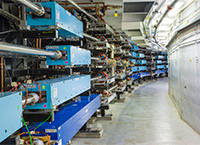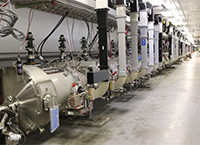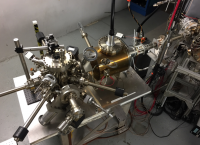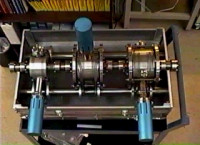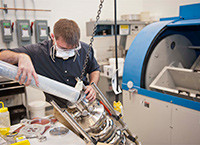Advancing Accelerator Science, Technology and Operations
Jefferson Lab is a world leader in accelerator science. This expertise comes from the planning, building, maintaining and operating of the Continuous Electron Beam Accelerator Facility (CEBAF), the lab’s primary particle accelerator, and the Low Energy Recirculator Facility, a test bed for a variety of technologies.
CEBAF is based on superconducting radiofrequency (SRF) technology. It produces a stream of charged electrons that scientists use to probe the nucleus of the atom. CEBAF was the first large-scale application of SRF technology in the world, and it is the world's most advanced particle accelerator for investigating the quark structure of the atom's nucleus. The CEBAF energy was recently upgraded from 6 GeV to 12 GeV, and an additional experimental area was added to support the highest-energy experiments.
The Upgraded Injector Test Facility (or UITF) is located within the North-West side of the Test Lab (Bldg. 58), and exists to provide a robust proving ground for a variety of accelerator technologies as well as providing a venue in which to perform low energy physics experiments.
The Jefferson Lab Low Energy Recirculator Facility is powered by a smaller SRF accelerator. Formerly known as the Free-Electron Laser (FEL), the facility holds power records in the production of infrared, ultraviolet and terahertz laser light. The FEL was used in a variety of scientific studies, such as developing processes for producing high-quality carbon and boron-nitride nanotubes, identifying laser light wavelengths for use in medical treatments and in micromachining studies.
The Jefferson Lab Accelerator Division is responsible for delivering high-quality electron beams for experiments, using a sophisticated computer system to control hundreds of thousands of hardware components, including complex cryogenic, microwave, vacuum and magnet systems that comprise the accelerator. The division also pursues a broad program of theoretical and experimental research in accelerator and beam physics.
The Jefferson Lab Accelerator Operations group is responsible for delivering high-quality electron beams to the four experimental halls for experimental physics studies in the Continuous Electron Beam Accelerator Facility (CEBAF) and operations and maintenance of the Low Energy Recirculator Facility.
The Center for Advanced Studies of Accelerators (CASA) is dedicated to leading-edge research in accelerator and beam physics, both theoretical and experimental. Our core purpose is to discover, delve into, and disseminate pioneering knowledge in the realm of advanced accelerator and beam physics, with an emphasis on insights garnered from research with Jefferson Lab accelerators, and accelerator collaborations such as the Electron-Ion Collider (EIC). CASA core expertise includes recirculating linac and energy-recovery linac (ERL) design, operations, and upgrades; computational accelerator physics, including AI and machine learning; and advanced diagnostics R&D.
The Center for Injectors and Sources (CIS) is a start-to-end organization which designs, fabricates and operates electron photo-injectors. We support the Jefferson Lab mission by providing the polarized electron beams for the CEBAF nuclear physics program, advancing R&D of critical accelerator technologies, and through collaboration and student mentorship.
The Accelerator Engineering Systems' mission is to design and build reliable electronic systems including: RF systems, DAQ instrumentation and accelerator controls for the Institute of Superconducting Radiofrequency Science and Technology, the Continuous Electron Beam Accelerator Facility (CEBAF) and the Free Electron Laser (FEL) at Jefferson Lab.
The SRF Institute (consisting of SRF S&T and SRF Ops Departments) is a world leader in the advancement of superconducting radiofrequency (SRF) science and technology, the technology that acts as the “accelerator” in all large modern particle accelerators. Advances in this technology enable the next generation of particle accelerators. This technology benefits researchers, engineers and technologists in fields ranging from particle physics and the life sciences to materials science and industry.



